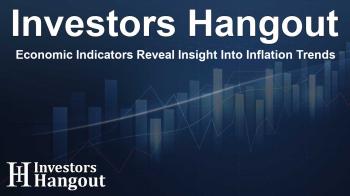Economic Indicators Reveal Insight Into Inflation Trends

Understanding Recent Economic Indicators
The Producer Price Index (PPI), an important measure of wholesale prices, recently exhibited stagnation, indicating no increase in prices for June. This data came as a surprise, as forecasts from various economists had predicted a rise. Notably, both the overall PPI and the core PPI showed figures that were lower than expected, with a core measure down at 0.20% below estimates.
Analyzing the trends over the past three months, the average PPI has hovered close to 0%. Furthermore, the annual PPI is recorded at just 2.3%, suggesting a more stable price environment than many anticipated. This poses a challenge to the common belief that tariffs are a significant driver of inflation, as the absence of considerable increases in producer prices indicates that manufacturers are managing costs without passing them onto consumers.
Despite tariffs influencing specific sectors, the overall inflation narrative may be overstated. The developments in PPI and the Consumer Price Index (CPI) provide the Federal Reserve with a degree of assurance—there is a possibility that the impacts of tariffs may not be as severe as feared.
Bank Earnings Exceed Expectations Amidst Market Concerns
Recent reports revealed that the major banks and brokers experienced earnings which generally surpassed expectations, despite their stock prices experiencing a retreat. The overview of earnings from notable financial entities sheds light on their performance:
- JPMorgan Chase (NYSE: JPM): Reported earnings per share (EPS) of $4.96, well above the estimated $4.48. They achieved a revenue of $44.91 billion, exceeding the expected $43.8 billion. However, JP Morgan's stock responded negatively due to a cautious outlook on Net Interest Income (NII) and rising expenses.
- Citigroup (NYSE: C): Surprised the market by reporting an EPS of $1.96 versus the anticipated $1.60, along with revenue of $21.67 billion, which was higher than the expected $21 billion. Citigroup also raised its outlook for full-year revenue.
- Wells Fargo (NYSE: WFC): Announced an EPS of $1.60, beating the estimate of $1.41, and revenue of $20.82 billion, which was slightly above estimates. Nonetheless, Wells Fargo's stock dipped by 5.48% as a result of a lowered full-year NII outlook.
- Goldman Sachs (NYSE: GS): Reported net revenue of $14.58 billion, surpassing estimates, and posted an EPS of $10.91 which excelled over the expected $9.59. They also saw notable increases in equity trading revenues and investment banking fees.
- BlackRock (NYSE: BLK): Achieved an EPS of $12.05, higher than the $10.79 estimate, with assets under management hitting a record $12.53 trillion, although they missed slightly on revenue, causing a 6% drop in stock price.
Amid ongoing challenges including elevated interest rates, these major financial players showed strength in trading and IPO activities. However, external pressures such as tariff-related uncertainties and broader economic conditions produced a tempered outlook for the market. The financial sector recently witnessed a decline of 1.7%, although it remains near historical highs.
Market Reactions and Predictions
The performance of banking institutions and the significant indicators in the economy paint a complex picture. Despite positive earnings, investor sentiment remains cautious, impacted by a mix of economic factors like rising interest rates and global trade challenges.
What Lies Ahead?
Looking ahead, the focus will likely shift to how both consumers and businesses respond to the evolving economic landscape. Continuous monitoring of the PPI, CPI, and central bank policies will provide insights into whether future inflation will prompt changes in economic strategies.
Frequently Asked Questions
What does the recent PPI data indicate?
The latest PPI data shows a zero percent increase for June, suggesting minimal inflationary pressure at the wholesale level.
How are major banks performing financially?
Major banks have reported earnings that exceeded expectations, although stock prices have declined due to various economic pressures.
What impact do tariffs have on inflation?
The current data indicates that while tariffs affect some sectors, they may not be driving overall inflation as initially assumed.
How is the stock market responding to these economic factors?
The stock market remains cautious amid concerns over tariffs and high interest rates, leading to mixed responses in bank stock prices.
What should investors watch for moving forward?
Investors should keep an eye on PPI and CPI trends as well as Federal Reserve policies to gauge future inflationary pressures and market movements.
About The Author
Contact Henry Turner privately here. Or send an email with ATTN: Henry Turner as the subject to contact@investorshangout.com.
About Investors Hangout
Investors Hangout is a leading online stock forum for financial discussion and learning, offering a wide range of free tools and resources. It draws in traders of all levels, who exchange market knowledge, investigate trading tactics, and keep an eye on industry developments in real time. Featuring financial articles, stock message boards, quotes, charts, company profiles, and live news updates. Through cooperative learning and a wealth of informational resources, it helps users from novices creating their first portfolios to experts honing their techniques. Join Investors Hangout today: https://investorshangout.com/
The content of this article is based on factual, publicly available information and does not represent legal, financial, or investment advice. Investors Hangout does not offer financial advice, and the author is not a licensed financial advisor. Consult a qualified advisor before making any financial or investment decisions based on this article. This article should not be considered advice to purchase, sell, or hold any securities or other investments. If any of the material provided here is inaccurate, please contact us for corrections.

